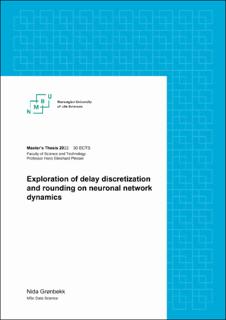| dc.contributor.advisor | Plesser, Hans Ekkehard | |
| dc.contributor.author | Grønbekk, Nida | |
| dc.date.accessioned | 2022-08-19T11:26:45Z | |
| dc.date.available | 2022-08-19T11:26:45Z | |
| dc.date.issued | 2022 | |
| dc.identifier.uri | https://hdl.handle.net/11250/3012689 | |
| dc.description.abstract | It is of great interest to try and simulate the neural activity in the human brain. This way one could possibly create models to help in diagnosing and treating disorders of the brain. This could lead to decreasing the costs of disorders of the brain. In order to make sure we can trust the simulations, several aspects have to be tested and investigated. In this thesis we want to explore how the rounding of delay values in neurons affect the spiking activity of the network as a whole. Is there a more correct way of rounding the delay values? And if we want to make simulations computationally more effective by discretizing both delay values and times, what resolution is necessary in order to achieve spiking activity similar to that of the exact solution?
We try to answer these questions by performing network simulations of both the Brunel and Microcircuit network, for three different models. The first model is a continuous model with continuous delay values and times. This will be viewed as the exact model. In addition we will look into two discrete models with discrete delay values and times. One where each delay value have the same probability of being drawn, and one where the end points of the interval only have half the probability of being drawn. The two discrete models are simulated for several choices of resolution. They will be compared by their statistics, calculated based on the spike times. In addition to comparing the statistics visually, we calculate distance measures based on these statistics.
In the results we see that there is no proof of one of the two rounding rules of delay values being more correct in the sense of being closer to the exact model based on the statistics. That is, whether the minimum and maximum delay value have the same probability of being drawn as the others or not, does not make a difference. We also observe that in order to get activity in the discrete models to be similar to that of the reference model, we need to use a resolution of 1/64. Using this resolution for the discrete models is computationally less expensive than simulating the continuous model in the case of the Microcircuit network. However this does not apply to the Brunel network. | en_US |
| dc.language.iso | eng | en_US |
| dc.publisher | Norwegian University of Life Sciences, Ås | en_US |
| dc.rights | Attribution-NonCommercial-NoDerivatives 4.0 Internasjonal | * |
| dc.rights.uri | http://creativecommons.org/licenses/by-nc-nd/4.0/deed.no | * |
| dc.title | Exploration of delay discretization and rounding on neuronal network dynamics | en_US |
| dc.title.alternative | Effekten av diskretisering og avrunding av signalforsinkelser på dynamikken av nevrale nettverk | en_US |
| dc.type | Master thesis | en_US |
| dc.relation.project | European Union’s Horizon 2020 research and innovation programme: 800858 | en_US |
| dc.description.localcode | M-DV | en_US |

